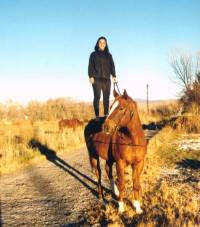
Do you want to teach your horse basic maneuvers such as picking up the correct lead, side passing, or rolling the hind? Would you like to know what diagonal or lead you are on without having to look down? Or do you want to do more complicated moves with your horse like spins, haunches-in, or sliding stops?
To teach your horse all of these moves requires one basic thing: knowing where your horse's feet are at any given time. To know where your horse's feet are without actually looking down all the time, you need to develop "feel," meaning that you need to be able to feel the placement of your horse's feet and body.
Developing "Feel" in Horse Training
If you have ever tried to develop the ability to know how your horse is positioned without looking, then you might know that the process can be frustrating, if not downright annoying. After all, how are you supposed to be able to "feel" your horse's feet, which are very far away from you?
Luckily you can start with baby steps and work your way up. There are two exercises that I found to be very useful when I first started trying to sense the placement of my horse's feet. Both are done at the trot, which seems to be the easiest gait for me to sense what is happening.
1. Sitting Trot
At the sitting trot you can develop feel by noticing how your hips and seat bones shift from side to side and up-and-down as the horse stretches forward with one diagonal pair of legs, and then with the other pair. You will notice that on any given stride one of your hips will move down and back while the other hip moves forward and up. Begin to correlate the movement of your horse's front feet with a certain position of your hips. For instance, you might say, "Ah, when my hips are positioned like this, my horse's right front leg is forward and the left front leg is back." Making this connection between your visual sensing and your body's position is the first step in developing 'feel.'
You can also do a more advanced version of this execise. As you are sitting the trot, sense which front hoof is moving forward and which one is back without looking down. You'll find, in time, that you will be able to 'see' the movement and position of your horse's front legs in your mind's eye. Look down from time to time to check whether your senses are correct. Don't worry if you find that you are often wrong. Stay with the exercise until you develop the right feel. Trotting down a long straight trail is perfect for practicing this exercise. It took me many rides down the ditch bank before I developed an accurate feel, but the time spent was well worth it.
2. Posting Trot
You can also practice developing feel at the posting trot, and this is an especially useful option if you find the sitting trot difficult. The posting trot is where you rise up out of the saddle and put your weight in the stirrups every other stride. As you trot down a long trail, pick up a random diagonal (or rise up out of the saddle on a random stride). Notice the sensations in your hips and seat bones as you post in this random diagonal. Then look down and check your diagonal (if you don't know about diagonals, just notice which front leg is forward as you rise up out of the saddle). Make the association between the way your body feels and the diagonal. Next, stay up out of the saddle for a random number of strides, and then pick up the posting trot again. Sense whether the sensations are the same or different than last time. As with the sitting trot you will feel one hip sitting lower and farther back in the saddle each time you sit. Keep working with the random diagonals until you develop a better feel.
To do a more advanced form of this exercise, stand up in your stirrups (a position called two point) as you trot. Sense the forward and backward movement of your horse's front legs. Try to 'see' them in your mind's eye. Look down periodically to check if you are correct. Don't be discouraged when you are incorrect, just keep practicing. Once you master these exercises, you will have a solid foundation from which to further develop your feel for more advanced manuevers.
What About You?
Do you have any great exercises for developing 'feel' from the saddle? If so, please write a comment so that we can all benefit! Thanks for stopping by!
If you enjoyed this post, please consider leaving a comment or subscribing to the feed to have future articles delivered to your feed reader. Also, check out my ebook for wacky horses and humans, or holler at me if you want to know how I fund my horse addiction ... and you can, too!
photo credit: http://www.flickr.com/photos/spakattacks/1593003570/





